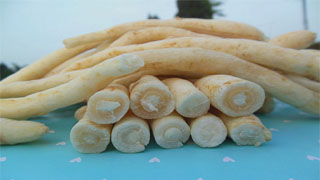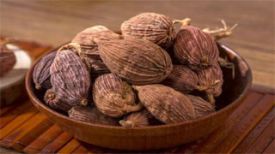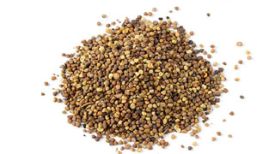
1. Alias
Fensha ginseng, earth ginseng, mountain radish, and Ming sha ginseng.
2. Plant morphology
Perennial herb. The basal leaves have long stalks, and the base expands into a sheath like shape to embrace the stem; The leaves are broadly ovate in shape, with 2-3 feather like divisions and small lobes lanceolate. The flower stem is often pulled out from one side, upright, and sparsely branched at the upper part; The inflorescence grows at the top, forming a sparse and broad cone-shaped compound umbrella shaped inflorescence, without a bracts, with 5-10 stalks, thin and soft; Several small bracts, cone-shaped; 10-15 slender umbrella stems; Small flowers; Calyx with 5 fine teeth; Petals 5, ovate lanceolate, white; Stamen 5, anthers elliptical, filaments slender; Ovary lower elliptical, style 2, spreading; The pistil of lateral inflorescence is often infertile. The double hanging fruit is wide elliptical in shape, smooth with longitudinal lines, and the fruit edges are not obvious. The flowering period is from April to May, and the fruiting period is from May to June.
3. Origin distribution
Born in sparse shrubbery and fertile soil in the mountains, or in crevices or rocky slopes in the mountains. Distributed in Jiangsu, Anhui, Zhejiang and other places.
4. Harvesting and processing
Excavate in spring, remove stems, leaves, and roots, wash the soil, boil in boiling water until there are no white hearts, remove, scrape off the outer skin, and dry in the sun.
5. Characteristics of medicinal herbs
Cylindrical, spindle shaped or irregular block, slightly twisted, 6-20 cm long, 0.5-2 cm in diameter. The surface is yellow white, smooth, semi transparent, often with longitudinal grooves, and some have reddish brown spots. Hard and brittle in texture, with a keratinous appearance, thick and short, not easily broken; The broken surface is flat and yellow white; The skin is thin, yellow white, and easy to peel off from the wood. The wood color is relatively light, and those that are thick and short are sometimes hollow. The air is faint and the taste is light.
6. Sexual Taste Returning to the Classics
Slightly cold in nature, sweet and slightly bitter in taste. Return to the lung meridian, spleen meridian, and liver meridian.
7. Effect and Function
Moisturize the lungs and phlegm, nourish yin and stomach, calm the liver, and detoxify. Belonging to the subcategory of liver calming and wind calming drugs, it is a medicine that can suppress liver yang.
8. Clinical application
The dosage is 3-9 grams. Used to treat symptoms such as wind heat cough, yellow and sticky phlegm, dry mouth and sore throat, toxic ulcers, redness, swelling, heat pain, vomiting due to spleen and stomach disharmony, and damp heat.
9. Pharmacological research
Pharmacological studies have shown that this product has the effects of removing phlegm, stopping cough, and relieving asthma, as well as regulating blood lipids, antioxidation, and anti stress; It has a promoting effect on small intestinal peristalsis in normal mice.
10. Chemical composition
Containing volatile oil, the volatile oil contains more than 50 compounds, and 10 components have been identified. Among them, the highest content of methyl 6,9-octadecadiynate is considered an effective ingredient for moistening the lungs and resolving phlegm; It also contains over 20 amino acids and 18 trace elements; L-asparagine may be its effective ingredient in relieving cough and asthma. The content of L-asparagine in Codonopsis pilosula can be determined by thin-layer scanning method. It also contains polysaccharides from Codonopsis pilosula and trace elements.
11. Usage taboos
People with spleen and stomach deficiency who are prone to diarrhea and pregnant women should not take it. Excessive consumption can easily cause swelling.
12. Compatibility prescription
① Treatment of lung heat cough: 9 grams each of Codonopsis pilosula, Mulberry white skin, and Loquat leaves, and 3 grams of raw licorice. Fry and serve. (Zhejiang Medicinal Plant Chronicles)
② Treatment of pregnancy vomiting: 9 grams each of Mingdangshen, Zhuru, and Shengbaizhu, 5 grams of Huangqin, and 3 grams of licorice. Boil it in water. (Anhui Chinese Herbal Medicine)
③ Treatment for fatigue injury, anemia and dizziness: 30g of finely chopped Codonopsis pilosula, 2 eggs, crushed and evenly mixed, steamed cooked food in a rice cooker. (Food, Traditional Chinese Medicine, and Toilet Formula)
④ Treatment of hypertension: 15 grams of Codonopsis pilosula and 15 grams of Achyranthes bidentata. Boil it in water. (Food, Traditional Chinese Medicine, and Toilet Formula)
⑤ At the beginning of treating vaginal discharge: Take 90 grams of sliced Codonopsis pilosula and steam it over Chen Shao wine and rice. Divide into three servings. (The Hundred Grass Mirror)
⑥ To treat Yangmei poisoning: Take ginseng from the soil and decoct it in wine. (The Compendium of Materia Medica cites Wang Anqing's "Collection of Medicinal Herbs")
⑦ Treating sores, swelling and toxins: 9g of Codonopsis pilosula, 15g of Dandelion and 15g of Zingiberaceae. Boil it in water. (Anhui Chinese Herbal Medicine)
⊙ The content of the article is for clinical reference only. Non TCM professionals are not allowed to test drugs.


